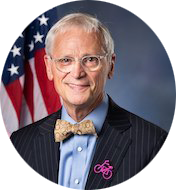Unprecedented.” “Historic.” “Once-in-a-generation.” These are some of the ways that the thought leaders presented here describe the Inflation Reduction Act and the Infrastructure Investment and Jobs Act. Together, the two acts will invest nearly $700 billion into American infrastructure, energy production, carbon reduction, deficit reduction, and much more. To give a sense of scale, the IIJA alone promises to invest nearly five times as many inflation-adjusted federal dollars per year as the 1956 Interstate Highway Act.
How will these investments affect cities? In Phoenix, Mayor Kate Gallego sees the IIJA as an opportunity to reimagine her city’s waterfront and reconnect segregated communities. In Rochester, Minn., Mayor Kim Norton will invest in more BIPOC women in the construction workforce and transition her city to renewable energy. Across the country, there is a chance to rethink infrastructure that has for too long privileged cars, and instead lift up alternative modes of transportation. Cities will also have to consider what are the best ways to leverage funding for climate change mitigation and adaption.
Many of the experts here make one thing clear: cities must be strategic. As Penn IUR Faculty Fellow Mark Alan Hughes writes, “To take full advantage of these opportunities, cities will need to engage in some smart policy design of their own.” Henry Cisneros warns that without strategy, even a funded project may miss out on “the needed multiplier punch to achieve its full potential.”
Local leaders will need to lean on knowledge networks such as the National League of Cities, which is eager to support small and mid-sized cities to ensure they get their piece of the funding pie. And they will need to work state-level leaders and agencies, such as those described by Senator Chris Murphy and Congressman Earl Blumenauer, to ensure they coordinate their local projects with greater regional ambitions. Leslie Richard notes that the key to regional success will be "developing purposeful, innovative partnerships."
These two pieces of landmark legislation have the potential to transform America. Read on to glimpse the challenges and opportunities that will come with this monumental moment.
—Eugénie Birch and Susan Wachter, Co-Directors, Penn IUR
Expert Voices 2023: Landmark Legislation, New Opportunities
Unprecedented Investments, New Opportunities | Clarence Anthony
The Value of Getting it Right | Earl Blumenauer
The Importance of Being Strategic | Henry Cisneros
Reimagining the Riverfront | Mayor Kate Gallego
Invest in Virtuous Cycles for Transportation | Erick Guerra
Using Smart Policy Design to Reap Funding's Full Rewards | Mark Alan Hughes
State and Local Leadership Can Partner for Successful Projects | Senator Chris Murphy
Developing a More Diverse Workforce and Sustainable City | Mayor Kim Norton
Positioning Regional Transit to Compete | Leslie Richards
Address Intersecting Mobility, Equity, and Safety Crises | Megan Ryerson
Make Streets Safe for the Most Vulnerable | Harriet Tregoning
Adopt Innovative Approaches to Mobility | Shin-pei Tsay
Plan for a Century of Sustainable and Equitable Growth | Tom Wright
Unprecedented Investments, New Opportunities
Clarence Anthony
Cities, towns and villages across America are already reaping the benefits of the Infrastructure Investment and Jobs Act (IIJA), with many large cities already announcing projects that will help repair major roads, build new bridges, and upgrade transit systems. The new law offers communities a historic chance to kickstart innovative infrastructure projects using competitive grants – meaning strong opportunities to improve railways, create safer roads, work toward a clean energy future, and clean up brownfield sites in neighborhoods that have historically been left behind. At the same time, the new Inflation Reduction Act gives city governments access to even more clean energy funding and new opportunities to take advantage of tax credits through the direct payment provision.
For local leaders, these new federal opportunities bring unprecedented investments, but they also bring new challenges. And for small communities, it can be frustrating to know about federal resources for community projects, but not have the networks, capacity, or expertise necessary to apply for or receive them.
The National League of Cities is here to help – not just to advocate for the resources cities need, but to ensure that small communities don’t miss out on this unprecedented opportunity because of their size alone. Our Local Infrastructure Hub, launched last year in partnership with Bloomberg Philanthropies, provides specialized training courses for small and mid-sized cities to help them take advantage of grant programs in these laws as they become available. Over the next two years, the Hub is offering at least 30 bootcamps corresponding with various grants on topics including expanding equitable broadband access, building up climate-resilient infrastructure, mitigating the impacts of flooding, and so much more.
This is a new era for infrastructure – and this legislation offers a ripe opportunity to address pressing urban challenges and improve the ways we build our communities to last in the long run.
Clarence E. Anthony is the CEO and Executive Director of the National League of Cities, and previously served as the Mayor of South Bay, Florida.
 The Value of Getting it Right
The Value of Getting it Right
Earl Blumenauer
I came to Congress determined to make the federal government a better partner to local communities so they can be safe, healthy, and economically secure. Under Democratic leadership, the 117th Congress made unprecedented progress to be that better partner. The enactment of the Infrastructure Investment and Jobs Act (IIJA) and the Inflation Reduction Act (IRA) will generate hundreds of billions of dollars of long-awaited investment into communities across America.
For those who have struggled with the deteriorating and underfunded inventory of our nation’s roads, bridges, and broadband infrastructure, the IIJA is a welcome signal that Congress can come together to invest in what Americans need. It is a once-in-a-generation effort to build the infrastructure that our future demands.
The IRA is the single largest investment in U.S. history to combat the climate crisis. Several key provisions I authored were included in the final bill, the most important of which may be accelerating renewable energy development. We’re also finally reinstating the Superfund tax to make sure that polluters pay to fix problems they created. There are a host of other provisions including electrifying our transportation system. Together it puts our country on track toward a critical 40 percent reduction in emissions by 2030.
This federal support could not come soon enough. These very basic infrastructure needs are finally being addressed. Beyond that, there are serious consequences for our citizens. Failure is extraordinarily costly in terms of health, income inequality, and the housing crisis. As we’ve struggled through the pandemic, it’s clear that these challenges are all interconnected. The principal of restorative justice also has multiple benefits, but only if we get it right.
Getting the implementation of the IRA and IIJA right means we’ll spend less time dealing with failure, and more time making progress for this century and beyond.
Congressman Earl Blumenauer has served as the U.S. representative for Oregon's 3rd congressional district since 1996.
 The Importance of Being Strategic
The Importance of Being Strategic
Henry Cisneros
The cities that will have the greatest success deploying funds from the IIJA and the IRA will be those that are guided by an overarching framework of strategic goals. Those that have such a framework will be able to integrate the specific opportunities presented by federal infrastructure funding to prepare for the future. This is in contrast to responding to disconnected announcements, reacting to uncoordinated powerful interests, or impatiently competing for the first funding available.
Cities should develop strategies and goals that consider the specific problems they confront and then set forth paths toward solutions. Cities have choices in how they set broad goals and then establish specific priorities. One city may set goals to increase overall economic growth and then choose priorities to stimulate tech start-ups through accelerators and incubators. Another city may set goals related to reducing racial and ethnic economic disparities and then choose priorities intended to rebuild obsolete infrastructure in marginalized neighborhoods. Some cities may combine such goals to sequentially pursue transformative priorities such as pursuing economic growth for the explicit purpose of achieving greater equity by prioritizing procurement from overlooked small and minority businesses for infrastructure projects in areas of concentrated poverty.
The point is that the city that sets a strategic course is more likely to know what federal infrastructure grant they should look for and how they will use funded projects to track their transformative path.
Cities that do not use a thoughtful strategic process are likely to receive information anecdotally, apply for funding disjointedly, and may indeed succeed in securing a specific grant but its effect is not likely to have the needed multiplier punch to achieve its full potential.
Cities can be masters of their own destinies, but that is more likely when they have understood the true essence of their economic and demographic trajectories, set a path to a stronger future, and use that knowledge as the basis to secure and deploy available resources, including those from the IIJA and the IRA.
Henry Cisneros served as the served as Secretary of Housing and Urban Development (HUD) in the Clinton administration from 1993 to 1997 and as Mayor of San Antonio, Texas from 1981 to 1989.
 Reimagining the Riverfront
Reimagining the Riverfront
Mayor Kate Gallego
Phoenix gets its name because the city rose from the ashes of the Hohokam community that once farmed along the Salt River. Our city wouldn’t exist without the Salt River. The agriculture that the river supported was the backbone of our early economy, and so much of our early development was designed around the river. Like many cities, our development eventually moved away from the river, and much of the land around it became industrial. The river became a dividing point for the city, with primarily Latino and African-American communities south of the river.
The Infrastructure Investment and Jobs Act (IIJA) gives us the chance to reinvest in our riverfront and reconnect our city. Through a $25 million Rebuilding American Infrastructure with Sustainability and Equity RAISE grant under the IIJA, we will connect these communities via a first for Phoenix: a pedestrian/bicycle bridge over the river. About one-fifth of households in the project area are without a car and must depend on transit and active transportation to get around town. This catalyzing investment has already drawn new projects involving environmental restoration, tree plantings, and solar-illuminated pathways to connect users with our light rail system. Even the NFL is putting charitable dollars into the area to celebrate the upcoming Super Bowl.
The federal IRA and IIJA inspired our own $500 million General Obligation Bond Program. A $23.5 million chunk of bond funds, once approved by voters, will go toward land acquisition along our riverfront, ensuring real estate is available for future economic development as well as for environmental assessments and cleanup as needed.
Thanks to the support of the federal government, Phoenix is rising again and moving boldly toward an ever more promising and exciting future.
Phoenix Mayor Kate Gallego oversees the fifth largest and fastest-growing big city in the nation and is the second-elected female mayor in the city’s history.
 Invest in Virtuous Cycles for Transportation
Invest in Virtuous Cycles for Transportation
Erick Guerra
With around $550 billion in new federal spending over five years, the Infrastructure Investment and Jobs Act promises to invest nearly five times as many inflation-adjusted federal dollars per year as the 1956 Interstate Highway Act. The IIJA funding will be split across a range of investments: approximately one-fifth will go to highways, one-fifth to transit, and the remainder to ports, water infrastructure, resiliency, research, electric vehicles, safety, and the power grid.
By continuing to invest in highways, the IIJA perpetuates a cycle of environmental, social, and economic harm. More driving produces more pollution, more traffic fatalities, and more cities and towns that are nearly unlivable without access to a car. As the federal government funds more highway infrastructure than local governments can afford to maintain, these investments contribute to deteriorating roads, bridges, and overpasses. For example, Philadelphia repaved just 60 or so of its 2,180 miles of roadway last year.
Despite stated policies to improve safety, reduce congestion, manage assets better, and reduce environmental harm, federal transportation laws tend to encourage one-off capital investments. Although city leaders may be tempted to use the IIJA to invest in large, signature projects, they should instead focus on leveraging federal funds to improve social, economic, environmental, and fiscal sustainability.
Replacing traffic lights may not be the flashiest investment, but modern traffic signals can cut energy and maintenance costs while also providing systems to better manage traffic, prioritize buses at intersections, shift timings to discourage speeding, and facilitate unusual traffic patterns due to special events and collisions.
Automated traffic enforcement, such as speed cameras, has a proven track record of reducing speeding, traffic collisions, and injuries. Speed cameras on Roosevelt Boulevard in Philadelphia decreased speeding infractions by around 90 percent. Collisions, injuries, and fatalities have also decreased by around 50 percent relative to other arterials. The economic savings from estimated reductions in traffic fatalities is more than 5 times higher than the $22 million dollars in annual revenues. These revenues, moreover, are being reinvested in other safety programs, creating a virtuous cycle.
Congestion charging, whether along busy highway corridors or in crowded city centers, can improve traffic flow and bus service, and provide much needed sustainable revenue sources for transit. London’s downtown congestion zone not only improved travel times, but also provided funds to increase bus service. In New York, the funds from a new congestion pricing scheme will be used to address decades of deferred maintenance on the city’s heavily used subway system. Instead of further investing in highway and rail expansion, congestion pricing on the Schuylkill Expressway could improve accessibility by bus and car, while raising revenues for other projects, such as more frequent bus service to King of Prussia, the region’s second largest job center.
Investing in congestion charging, automated traffic enforcement, and modern traffic signals would create new virtuous cycles that not only provide immediate benefits upfront, but also help to fund better mobility and sustainability outcomes in the future. Despite stated policies to improve safety, reduce congestion, manage assets better, and reduce environmental harm, federal transportation laws tend to encourage one-off capital investments. To help cities thrive, federal policymakers need not only to allow but encourage more creative uses of funds to promote social, environmental, economic, and fiscal sustainability.
Erick Guerra is Associate Professor and Director, Cm2 University Transportation Center, at the University of Pennsylvania Stuart Weitzman School of Design.
 Using Smart Policy Design to Reap Funding's Full Rewards
Using Smart Policy Design to Reap Funding's Full Rewards
Mark Alan Hughes
The Inflation Reduction Act (IRA) and the Infrastructure Investment and Jobs Act (IIJA) are two of the best designed, and therefore potentially most impactful, pieces of federal legislation since the 1990 amendments to the Clean Air Act, perhaps even since the Medicare and Medicaid Act of 1965. Good policy design derives from identifying solution mechanisms that can be well-matched to public problems.
In just one example of its successful policy design, the IRA provides households with certainty over a long horizon for energy decisions they make, which in turn will help the U.S. mitigate climate change. The IRA guarantees tax credits for a broad set of potential purchases in energy production, such as solar panels, and energy consumption, such as induction cooktops, for the next 10 years. Over $40 billion in mostly refundable tax credits are made available to U.S. consumers for purchases of electric vehicles, energy-efficient appliances, rooftop solar panels, energy storage, geothermal, insulation and sealing, and more powerful home electrical equipment. Households can make these changes in any order and at any pace over the decade guaranteed by the IRA. The policy design aligns the investment horizon and options with decision-making in a way that best suits the needs and means of varied households.
To take full advantage of these opportunities, cities will need to engage in some smart policy design of their own. The IRA and IIJA provide resources, but cities will need to make sure it is someone’s job to accelerate the clean energy transition by acquiring and leveraging those funds. For the past 50 years or so, cities have seen the benefits of working with affordable housing, community health, and early childhood intermediaries to achieve their goals and targets. A number of U.S. cities are fortunate to have agencies and/or authorities that have developed significant organizational capacity to support a local energy transition and fulfill sustainability plans. This capacity will serve these cities well as resources begin to flow from the IRA and IIJA.
I was the City of Philadelphia’s Chief Recovery Officer during the American Recovery and Reinvestment Act (ARRA) period, when then-Vice President Joe Biden directed the federal stimulus. I recognize much of the “shovel-ready” tempo from ARRA in the recent legislation. Cities that organized back then will be best positioned now to make use of the largest flow of federal support in a generation.
Mark Alan Hughes is Faculty Director, Penn's Kleinman Center for Energy Policy; Professor of Practice, City and Regional Planning, Weitzman School of Design; and Penn IUR Faculty Fellow.
_(1)_edited.png) State and Local Leadership Can Partner for Successful Projects
State and Local Leadership Can Partner for Successful Projects
Senator Chris Murphy
The Inflation Reduction Act (IRA) and the Infrastructure Investment and Jobs Act (IIJA) provide billions for cities to address climate change and combat racial injustice. For instance, the new Reconnecting Communities program will fund projects that reconnect urban areas previously isolated by highways, and the Environmental and Climate Justice Block Grant will fund projects that mitigate climate change in historically disadvantaged communities. Even in programs that don’t explicitly have a climate or racial justice focus, a project that addresses these issues may be more competitive for funding opportunities like the Rebuilding American Infrastructure with Sustainability and Equity (RAISE) grant, which has a $15 million set-aside for projects in historically disadvantaged communities.
While all this is good news, I hear from mayors in my own state that it’s overwhelming to identify the best funding opportunities and submit competitive applications. Here are some tips:
- Talk to your state and county leadership: Both the IIJA and IRA provide funding that can flow directly to cities and states, which then allocate it to projects. Talk to your state agencies and county officials about your general needs as well as specific projects to understand the best way to get your projects funded.
- Call your congressional representatives: Congressional staff wrote these bills, and they can help you identify grant programs best matched to your needs. They can also help ask federal agencies technical questions about your project proposal.
- Engage with federal agencies: Participate in technical assistance webinars, review guidance documents, and ask agencies for feedback if your application is not successful. Also, as both the IIJA and IRA will be rolled out over many years, engage with these agencies about ways they can do better in the future–maybe it’s longer application windows, more funding for project planning, or conducting more community outreach.
Chris Murphy is the junior United States Senator for Connecticut.
 Developing a More Diverse Workforce and Sustainable City
Developing a More Diverse Workforce and Sustainable City
Mayor Kim Norton
Last year, the City of Rochester was the recipient of a $1 million Bloomberg Philanthropies Global Mayor’s Challenge Grant, and our focus, rather fortuitously given the passage of the IRA and IIJA, is on building a diverse workforce by focusing on bringing Black, Indigenous, and People of Color (BIPOC) women into the construction/built environment fields. Additionally, we are utilizing Infrastructure bill funding from the Department of Labor to supplement the creation of these career pathways for BIPOC women – thus addressing both economic disparities and racial justice. We are also participating in a National League of Cities Initiative called “Inclusive Entrepreneurship” which will take this concept to the next level by building an entrepreneurship pipeline for these (and other) women so they can own and grow companies.
The City is also convening a group of cross-departmental teammates (employees) to evaluate city energy efficiency projects that may be competitive for IRA and IIJA funding and programs. These include projects related to climate change and greenhouse gas reductions (a goal of the city and with our municipal utility’s commitment, and city council vote of approval, is to be 100 percent renewable by 2030), affordable/workforce housing projects, and electric vehicle charging infrastructure throughout the city.
We are evaluating the best support team to help us navigate the revised tax credit programs particularly for our $15 million Downtown Business Energy Transition Project and the longer-range renewable energy needed. We are developing an “Electrify Rochester” campaign for residents to educate them on the opportunities available through both acts including creating a landing page of resources for community members to access. We’ll be using our Energy Efficiency Block Grant funding to assist low-income homeowners/renters in closing the gap on energy efficiency and electrification projects that either act may not fully cover. We are building out scenarios, guides, and timelines for various income levels in addition to preparing materials to engage with contractors, manufacturers, and lenders.
Kim Norton is in her second term as Mayor of Rochester - Minnesota’s third largest city and home of Mayo Clinic.
 Positioning Regional Transit to Compete
Positioning Regional Transit to Compete
Leslie Richards
The Federal Bipartisan Infrastructure Law presents an historic opportunity with billions of dollars available in federal competitive grants to improve Pennsylvania infrastructure. SEPTA is putting the Infrastructure Investment and Jobs Act (IIJA) to work for Pennsylvanians as best as it can.
The IIJA funds will accelerate State of Good Repair and advance Projects of Significance, which is great news.
This progress gives us hope for breaking the cycle of status quo and underscores that investment in transportation must become a priority for Pennsylvania. New investment in public transportation is essential to meet the mobility demands of the growing southeast region and its 4.5 million residents.
While the landmark federal infrastructure law will bring hundreds of millions of dollars for highways and transit in Pennsylvania through increased formula funding, a significant portion of the funding for transit will come in the form of competitive grants. Pennsylvania must position itself now to compete in the federal grant process to tap into the new federal investment available in the Bipartisan Infrastructure Law.
We need the help and support of state and local partners to leverage this once-in-a-generation opportunity. SEPTA’s ability to meet the future needs of the region will play a significant role in how fully the region can recover from COVID, grow, and continue to support the statewide economy.
Local and regional investment options are needed to strengthen our application for federal competitive grants and leverage significant federal investment to advance projects that benefit our counties, region, and state. Without these options, Pennsylvania will fall farther behind competitor regions that are investing double what Pennsylvania is.
It is my hope that by developing purposeful, innovative partnerships that take advantage of the opportunities put forth through the IIJA, we’ll be able to secure a vibrant economic future for Southeastern Pennsylvania and the Commonwealth.
Leslie Richards is the General Manager of SEPTA, the public transportation agency serving the Philadelphia area, and a Professor of Practice at the University of Pennsylvania Stuart Weitzman School of Design.
 Address Intersecting Mobility, Equity, and Safety Crises
Address Intersecting Mobility, Equity, and Safety Crises
Megan Ryerson
The city of Philadelphia is facing numerous intersectional crises which, together, threaten the mobility of our residents. The public safety crisis is first: gun violence and other forms of physical violence in neighborhoods across the city, near and at schools, and on our public transit system keep people indoors and confined to their own personal vehicles. The second is a shortage of workers in the transit and public safety space, stemming from issues of pay, unpredictable work schedules, and poor and sometimes hostile working conditions (see issue #1). The third is a fundamentally unsafe transportation system. Philadelphia has the highest traffic fatalities per capita rates of the large cities – and one that is deeply inequitable, as the highest crash areas are often in the lowest-income neighborhoods. In short, people don’t feel safe walking and taking transit; this, along with depressed transit reliability due to worker shortages, has led more people to drive. The more people who drive, the more potential for fatal accidents and environmental degradation from fuel consumption.
The city needs to invest in not just physical infrastructure, but workforce and human infrastructure. New electric buses would be a huge benefit for the environment, but we also need people to drive them and people choose transit over using their cars. The city also needs to make common sense transportation safety interventions – curb bump outs to promote pedestrian safety and driver line of sight; loading zones for trucks so delivery trucks aren’t parked in cross walks – so that neighborhoods both feel safer and are actually safer places to walk. Finally, Philadelphia should heed the words of Gina South at Penn, who challenges the city to focus on neighborhood greening and care to reduce gun violence.
Megan Ryerson is the UPS Chair of Transportation and Associate Dean for Research at the University of Pennsylvania Stuart Weitzman School of Design.
 Make Streets Safe for the Most Vulnerable
Make Streets Safe for the Most Vulnerable
Harriet Tregoning
My advice to city leaders is to focus on creating safe places to walk, bike, scooter, and connect to transit for everyone who needs to travel to meet their daily needs. After all, that is the point of transportation. But in every community, we’re still having trouble meeting that basic threshold.
More than half of trips taken in the United States are three miles or less, yet most of those short trips are taken by car. Why? Safety. Countless surveys have revealed the same thing: many people would walk, bike, and take scooters if they were protected from heavy vehicles in fast-moving traffic.
This concern is particularly trenchant as annual pedestrian and cyclist deaths have reached an alarming 20-year high. Among the implicated factors: the growing prevalence of large, heavy, dangerous trucks and SUVs; distracted driving; and road design. Appallingly, but unsurprisingly, Black cyclists are three times more likely to be killed than white cyclists.
Growing racial and economic disparities in this country are leaving people behind, and so is the idea that everyone must and will drive everywhere. While it’s clear that the U.S. is making big strides and investments in electric mobility for a more sustainable future, electric vehicles alone do not address the reality that many people cannot drive or afford a car, or the fact that they just don’t want to use or own one.
In Washington, D.C., where I live, transit access tends to be very good, in part because D.C. is a pedestrian-scaled, walkable city. We also have a growing network of protected bike lanes. These low-cost and convenient options mean that residents spend 9 percent of their household income on transportation, compared to the 19 percent spent by the average household in the wider region. In times of economic uncertainty, D.C. residents have shifted to lower-cost options, shedding hundreds of automobiles during the Great Recession. This shift was only possible because most D.C. residents have access to affordable mobility (and the associated economic resilience).
In some cities, things already are changing. Over the last decade, we’ve seen the rise of even more mobility options like shared electric scooters, mopeds, electric bikes, and even cargo bikes. Cities are eager to work with employers and on-the-ground community advocates to try out innovative mobility solutions.
We must seize the opportunity afforded to us through historic federal investments in infrastructure to make our streets safe for the most vulnerable users and encourage affordable, low-carbon, accessible options like transit, walking, e-bikes, and e-scooters.
Harriet Tregoning is the Director of the New Urban Mobility (NUMO) alliance, housed at the World Resource Institute, where she works to make cities and their transportation and land use more accessible, sustainable, joyful, and just.
 Adopt Innovative Approaches to Mobility
Adopt Innovative Approaches to Mobility
Shin-pei Tsay
To maximize impact from federal funds, a fundamental shift in approach would be to redefine transportation so that it’s more mode-agnostic and more reflective of shared outcomes across city agencies. To increase transit use and encourage walking and biking, cities could consider DOTs and transit agencies as mobility managers and encourage partnerships to include shared mobility in operational planning, and for network redesigns. The inclusion of taxis, bike and scooter share, and TNCs to fill gaps allow transit agencies to dedicate resources to high-volume routes or provide a release valve where there’s over-demand, especially as travel patterns have changed after the pandemic. Cities could also create mobility wallets that fund people’s use of shared mobility to supplement their transit use, such as through low- and no-fare programs, guaranteed rides home, or late-night service.
To double down on transportation decarbonization and increase access, cities can make electric vehicles (EVs) available to a broader segment of the population. Currently, the relatively high cost of vehicle purchase and charging availability are the most significant barriers to EV adoption. To address these hurdles, cities could direct EV incentives to marginalized communities and launch EV education programs. They can launch ebike voucher programs like the City of Denver or rebates like the State of Vermont. For those who rely on cars, cities could work with local organizations to thoughtfully accelerate implementation of charging infrastructure in low-income communities, which tend to have more multi-unit dwellings and, thus, are less likely to have at-home access to vehicle charging.
The funding programs also contain opportunities to make sustainable mobility accessible to everyone. To make transit truly accessible, leaders should make sure to make transit stations ADA-compliant, especially in cities with legacy systems. As part of the electrification movement, cities could incentivize fleets to adopt electric, wheelchair-accessible vehicles. Fleet owners benefit from higher incentives when purchasing EVs that are WAV, as they do in Ireland.
To protect the most vulnerable and accelerate adoption of biking and walking, cities could combine funding from several programs to create complete street networks that also act as bioswales, urban forests, and cooling corridors to combat flooding and heat, especially in our most underserved communities. More biking and walking infrastructure that is safe and also provides climate adaptation helps make active modes more palatable in our rapidly warming and extreme climates.
Cities are facing a once-in-a-generation opportunity to reimagine what transportation can be. Mixing transit with shared modes, integrating safe street infrastructure with climate-friendly landscape design, and layering equity goals throughout all approaches are ways that city leaders can find win-wins with the federal programs.
Shin-pei Tsay works at the intersection of policy, design, and governance to shape inclusive sustainable cities and leads global cities and transportation policy at Uber.
 Plan for a Century of Sustainable and Equitable Growth
Plan for a Century of Sustainable and Equitable Growth
Tom Wright
The Inflation Reduction Act (IRA) and Infrastructure Investment and Jobs Act (IIJA) present the greatest opportunity for federal infrastructure funding that we will likely see in our lifetimes. However, after generations of under-investment and investing in too many of the wrong things, we need this funding to fulfill multiple goals. Fixing historic inequities and racist decision-making in the siting of infrastructure. Moving away from sprawl to create more livable, walkable and bikeable communities. Reducing our carbon footprint while protecting vulnerable communities from the impacts of climate change. Providing communities with safe, clean drinking water. And closing the digital divide.
To fully take advantage of this opportunity, cities and regions must figure out how to make the federal funding go as far as possible. This will require innovative partnerships that leverage private funding and creative designs that undo past mistakes and build new capacity for sustainable and equitable growth.
We must realize that time is not on our side. With inflation still above 5 percent, tight labor markets, and strained global supply chains, the cost of building megaprojects will explode in coming years. The Gateway project, which will double regional rail capacity under the Hudson River and transform New York Penn Station, will increase in costs by over $1 billion for every year of delay.
After several generations of missed opportunities and poorly designed projects, there is still a great deal of mistrust in many communities about how large-scale infrastructure projects are planned and financed. We need our public leaders to be clear about their vision for the future, what types of investments are priorities, and how we’ve learned from our mistakes. In New York City, we’re building complete streets, bike lanes, and greenspaces across all five boroughs. New subway extensions have been built on the Upper East Side and West Midtown. We’ve completed new train halls at Moynihan Station and the Oculus. In a few weeks, Long Island commuters will have the option of taking a train to Grand Central Terminal or Penn Station. And hopefully within a year, we will be charging all drivers into the regional Central Business District, using congestion pricing to manage traffic and generate billions in investments for sustainable mass transit.
We need to build on these successes and put the federal funds to work – now. If we can connect these investments to sound community planning, we can create the capacity for a century of sustainable and equitable growth.
Tom Wright is the President and CEO of Regional Plan Association, the nation’s oldest independent regional planning organization which prepares long-range plans for the New York/New Jersey/Connecticut metropolitan region.


